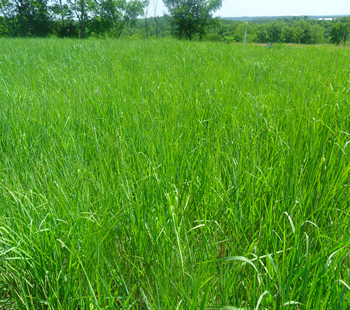Novel Endophyte Tall Fescue
 The most predominant forage grass in the U.S., covering over 36 million acres, happens to be tall fescue, a cool-season perennial grass. It is extremely prevalent in areas of the southeastern United States because it possesses desirable characteristics that include tolerance to drought, flooding, heavy grazing pressure, and a long growing season. Kentucky-31 Tall fescue contains a fungal endophyte that grows in the plant and is responsible for many of tall fescue’s desirable survival attributes. However, the fungal endophyte and the ergot alkaloids it produces (especially ergovaline) have been proven to be harmful to livestock and cause a syndrome called tall fescue toxicosis.
The most predominant forage grass in the U.S., covering over 36 million acres, happens to be tall fescue, a cool-season perennial grass. It is extremely prevalent in areas of the southeastern United States because it possesses desirable characteristics that include tolerance to drought, flooding, heavy grazing pressure, and a long growing season. Kentucky-31 Tall fescue contains a fungal endophyte that grows in the plant and is responsible for many of tall fescue’s desirable survival attributes. However, the fungal endophyte and the ergot alkaloids it produces (especially ergovaline) have been proven to be harmful to livestock and cause a syndrome called tall fescue toxicosis.
Symptoms of tall fescue toxicosis include a rough hair coat, decreased feed intake, weight gain, milk production, and fertility, and elevated body temperature. Cattle often spend less time grazing and more time in shade or water trying to cool off. Wild-type endophyte infected tall fescue greatly decreases animal gains and reproductive performance, estimated to cost the U.S. beef industry from $600 million to more than $1 billion annually.
Different varieties of tall fescue have become available that help producers decrease this economic loss. Endophyte-free tall fescue varieties do not contain the fungal endophyte, making them non-toxic, but this compromises the plant survival characteristics of wild-type endophyte infected tall fescue. This can negatively impact persistency, especially when forage is overgrazed and under drought conditions. Novel endophyte varieties contain special endophytes that enhance persistence, but do not produce or produce lower levels of ergot alkaloids, making them safe for livestock to graze. Available research has shown that grazing novel endophyte tall fescue results in excellent performance, while showing no symptoms of tall fescue toxicity. In different studies throughout the southeast, grazing novel endophyte tall fescue instead of an wild-type endophyte infected variety led to higher calf weaning weights and pregnancy rates of cows. Advantages of grazing novel endophyte tall fescue have been seen in stocker cattle that include smoother hair coats, lower body temperatures, spending more time grazing, and significantly higher weight gains.
Many companies market novel endophyte varieties, and likely your local seed store will carry one of these: Duramax Gold, Estancia with ArkShield, Jesup MaxQ, Texoma MaxQ2, and BarOptima Plus E34. For more information on novel endophyte tall fescue varieties, refer to UK Forage Extension. The forage extension website has electronic versions of variety test reports performed in Kentucky and surrounding states. See the novel endophyte tall fescue variety tests for yield. See also variety trials conducted on grazing tolerance and preference.
Planting novel endophyte tall fescue varieties is becoming increasingly popular, and more people are finding out that it’s a great way to establish tall fescue into a pasture without the negative performance effects to livestock. However, the advantage of novel endophyte tall fescue over wild-type endophyte infected tall fescue, such as the popular Kentucky 31 variety, does not come without having to pay a higher price at the store for the seed.
Even though the initial cost is higher, it may be more economical in the long run because it increases animal performance while improving plant survival over endophyte free varieties. Use good management practices when replacing an existing stand and realize that it may be necessary to keep animals off those fields for six months or more to allow seedlings to establish, but they can be used for hay during that time. During this time, it is important to consider grazing other established fields, giving animals stored feed, or decreasing herd size. It may seem management intensive, but making improvements to pastures that increase animal performance will have positive long-term returns.
Novel Endophyte Tall Fescue has long-term benefits that will overcome the initial cost of the seed. When deciding which variety best fits your operation, consider your farm goals, field available for renovation, cost of seed and labor, and long-term benefits. Contact your local county extension agent to assist in deciding on a best management plan for your farm.
Categories:
Summer
Forage Related Disorders


